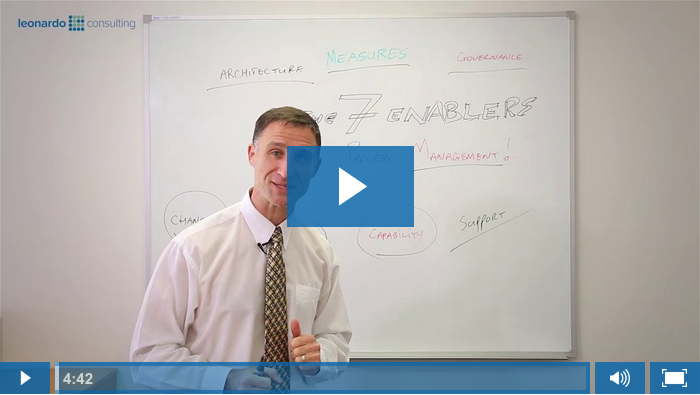The Process Session is a weekly video series posted on The Leonardo Blog that discusses all things BPM and Enterprise Architecture.
Each Friday, one of the Leonardo team will bring you an informal discussion about current news, ideas, tips and trends in the industry. Over the next few months, we will be talking about The 7Enablers of BPM.
Please let us know if you have any ideas for future topics for The Process Session.
Video Transcription - The 7Enablers of BPM Overview
Thanks for joining me today to talk about the 7Enablers of BPM.
So why would we want to do that? Most organizations are really struggling to deliver value to their clients and I believe that the only way that you can deliver value to an external customer is through your business process. Therefore it stands to reason that you need to manage your business processes if that is what is delivering the value.
Business Process Management is a philosophy of putting process in the center of business management. Most people know how to manage their businesses but they often neglect to look at the process which is what delivers value to clients.
How did we do that? We believe that these are the seven enablers that will help your organization mature in the management of its business processes which we sometimes call process-based management.
Process Architecture
The first one of the enablers is Process Architecture. The reason why this is important is because we are graphical beings and we like to see, touch and communicate what our processes are. We need a place where all of these processes can live, so we know where to get these processes, we know how they're behaving, what to do about them, and we need to know how to communicate and collaborate with these across the organization. So that's the first and most important artifact of your business process management and the first of the seven.
Process Measures
The next one is your Process Measures. Once you know your Process Architecture, you than need to be able to measure them, because how will you know that they can be improved if you don't know how they are currently performing. So once you've got your critical few measures in place, you can have them on your Process Architecture to ensure that you can see them. Then you need somebody that can keep an eye on them and constantly check: Are these the right target measures we want on a particular process? Are those processes performing and matching those? Is the external environment putting pressure on and making you have to decide what other new measures you need to put in place? The whole cycle needs to be in place to govern the all your business processes.
Process Governance
Process Governance is one of the key aspects of BPM, and many people have different ideas on what a process owner is - but fundamentally we believe that it's the person that's responsible for responding to the measures of your business processes.
Process Change
The next one is Process Change - change is central to process. Every process is impacted by people or supported by systems in some way shape or form. Therefore, if you're going to make a change to a process you need to know what you're changing and how it is going to impact on the everyone. Often that's left at the end of a process or project. We believe it needs to be done right at the beginning - it is central to business process management. We teach a little bit about that - on how to ensure changes embedded in your process of process improvement.
Process Mindset
The next one is Process Mindset. Changing the mindset of the whole organization. Organizations tend to want to resist change. Human beings naturally want to resist change. So we need to change the mindset and get people to think every day how are they going to come into work wanting to improve the process is that they work and are part of.
Process Capabilities
Once we've changed that mindset, everything else becomes a lot easier. We can build up Process Capabilities - to help people implement certain methods of “How do you do innovation?”, “How do you do process improvement?”, “How do you manage it?” (program management project management etc). That is building capability to suit your organization - because your organization is different as I'm always saying, and therefore you want to make sure that that is customized to suit your culture.
Process Support
The final one is Process Support. How do we support all of this so that it's all meshes well together? How well do all the tiny little cogs mesh well together? That is what we want to be able to see and ensure that everything's working everything's in the right place. Performing in the right way.





